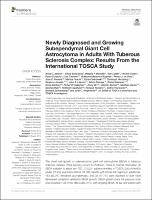| dc.contributor | Departament de Salut |
| dc.contributor.author | Jansen, Anna C. |
| dc.contributor.author | Belousova, Elena |
| dc.contributor.author | Perkovic Benedik, Mirjana |
| dc.contributor.author | Carter, Tom |
| dc.contributor.author | Cottin, Vincent |
| dc.contributor.author | Curatolo, Paolo |
| dc.contributor.author | Macaya Ruíz, Alfons |
| dc.date.accessioned | 2020-02-26T10:56:00Z |
| dc.date.available | 2020-02-26T10:56:00Z |
| dc.date.issued | 2019-08-02 |
| dc.identifier.citation | Jansen AC, Belousova E, Benedik MP, Carter T, Cottin V, Curatolo P, et al. Newly diagnosed and growing subependymal giant cell astrocytoma in adults with tuberous sclerosis complex: results from the international TOSCA study. Front Neurol. 2019 Aug 2;10:821. |
| dc.identifier.issn | 1664-2295 |
| dc.identifier.uri | https://hdl.handle.net/11351/4679 |
| dc.description | SEGA; TOSCA; Tuberous sclerosis complex |
| dc.description.abstract | The onset and growth of subependymal giant cell astrocytoma (SEGA) in tuberous sclerosis complex (TSC) typically occurs in childhood. There is minimal information on SEGA evolution in adults with TSC. Of 2,211 patients enrolled in TOSCA, 220 of the 803 adults (27.4%) ever had a SEGA. Of 186 patients with SEGA still ongoing in adulthood, 153 (82.3%) remained asymptomatic, and 33 (17.7%) were reported to ever have developed symptoms related to SEGA growth. SEGA growth since the previous scan was reported in 39 of the 186 adults (21%) with ongoing SEGA. All but one patient with growing SEGA had mutations in TSC2. Fourteen adults (2.4%) were newly diagnosed with SEGA during follow-up, and majority had mutations in TSC2. Our findings suggest that surveillance for new or growing SEGA is warranted also in adulthood, particularly in patients with mutations in TSC2. |
| dc.language.iso | eng |
| dc.publisher | Frontiers Media |
| dc.relation.ispartofseries | Frontiers in Neurology;10 |
| dc.rights | Attribution 4.0 International |
| dc.rights.uri | http://creativecommons.org/licenses/by/4.0/ |
| dc.source | Scientia |
| dc.subject | Esclerosi tuberosa |
| dc.subject | Astrocitomes |
| dc.subject | Adults |
| dc.subject.mesh | Tuberous Sclerosis |
| dc.subject.mesh | Astrocytoma |
| dc.subject.mesh | Adult |
| dc.title | Newly diagnosed and growing subependymal giant cell astrocytoma in adults with tuberous sclerosis complex: results from the international TOSCA study |
| dc.type | info:eu-repo/semantics/article |
| dc.identifier.doi | 10.3389/fneur.2019.00821 |
| dc.subject.decs | esclerosis tuberosa |
| dc.subject.decs | astrocitoma |
| dc.subject.decs | adulto |
| dc.relation.publishversion | https://www.frontiersin.org/articles/10.3389/fneur.2019.00821/full |
| dc.type.version | info:eu-repo/semantics/publishedVersion |
| dc.audience | Professionals |
| dc.contributor.authoraffiliation | [Jansen AC] Pediatric Neurology Unit, Department of Pediatrics, UZ Brussel VUB, Brussels, Belgium. [Belousova E] Research and Clinical Institute of Pediatrics, Pirogov Russian National Research Medical University, Moscow, Russia. [Benedik MP] Child Neurology Department, SPS Pediatriêna Klinika, Ljubljana, Slovenia. [Carter T] Tuberous Sclerosis Association, Nottingham, United Kingdom. [Cottin V] Hôpital Louis Pradel, Claude Bernard University Lyon 1, Lyon, France. [Curatolo P] Child Neurology and Psychiatry Unit, Systems Medicine Department, Tor Vergata University Hospital, Rome, Italy. [Macaya A] Neurologia pediàtrica, Hospital Universitari Vall d’Hebron, Barcelona, Spain |
| dc.identifier.pmid | 31428037 |
| dc.identifier.wos | 000478639000001 |
| dc.rights.accessrights | info:eu-repo/semantics/openAccess |

